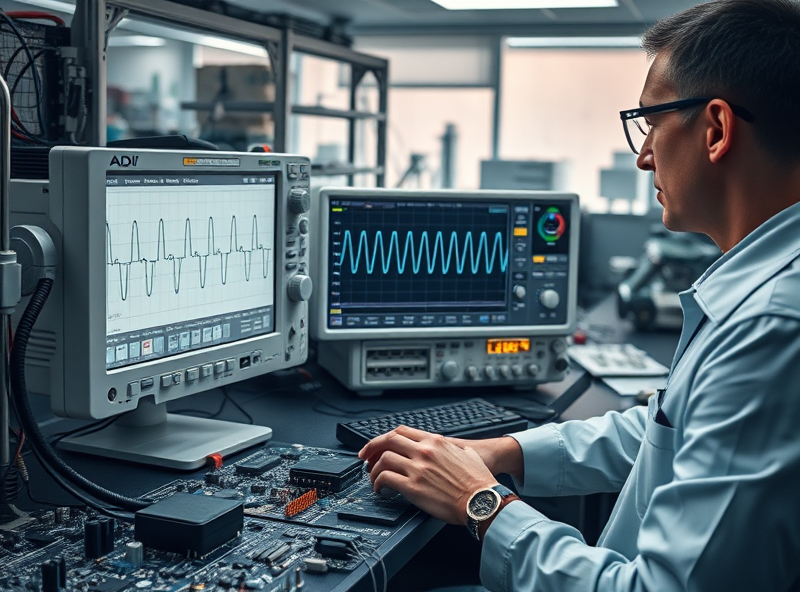
Why Analog Devices (ADI) Matters: Tech Backbone & Stock Growth Power
ADI’s Essential Role in the Future of Electronics

Analog Devices, Inc. (ADI) is not just another semiconductor company—it’s a critical enabler of the technologies shaping our future. From autonomous vehicles to smart healthcare devices, ADI’s precision analog, mixed-signal, and digital signal processing (DSP) technologies form the invisible backbone of modern electronics.
In a world increasingly driven by data and connectivity, ADI’s role becomes even more vital. Their high-performance sensors and signal converters are essential in capturing real-world data—like temperature, motion, sound, and pressure—and converting it into digital signals that machines can understand. This capability is foundational for the Internet of Things (IoT), 5G networks, and industrial automation.
For example, in electric vehicles (EVs), ADI’s battery management systems (BMS) ensure safe and efficient energy usage, directly impacting vehicle range and safety. In healthcare, their signal processing chips power advanced imaging systems and wearable health monitors, enabling more accurate diagnostics and real-time health tracking.
From a financial perspective, ADI has shown consistent growth and resilience. Their strategic acquisitions, such as the merger with Maxim Integrated, have expanded their product portfolio and market reach, positioning them strongly for long-term growth. For investors, this means ADI is not only a technology leader but also a compelling stock to watch in the semiconductor space.
In short, ADI matters because it enables the seamless interaction between the physical and digital worlds—something that’s becoming more essential every day.
For more on ADI’s technologies and impact, you can visit their official site: https://www.analog.com/en/index.html
Financial Strength and Stock Performance Factors

Analog Devices, Inc. (ADI) is not just a leader in high-performance analog and mixed-signal semiconductors—it’s also a company with robust financial health that makes it a compelling choice for long-term investors. Let’s explore how ADI’s financial strength directly contributes to its stock performance and why that matters for your portfolio.
ADI consistently demonstrates strong revenue growth, supported by its diversified product portfolio across industrial, automotive, communications, and consumer markets. This diversification helps stabilize earnings, even during economic fluctuations. For instance, in fiscal year 2023, ADI reported over $12 billion in revenue, with a gross margin exceeding 70%, showcasing its pricing power and operational efficiency.
One of the key indicators of ADI’s financial strength is its free cash flow generation. In recent years, ADI has maintained a free cash flow margin above 25%, which is significantly higher than many of its peers. This allows the company to reinvest in R&D, fund strategic acquisitions, and return capital to shareholders through dividends and share buybacks. As of 2024, ADI offers a dividend yield of around 1.8%, and it has a history of consistent dividend growth.
From a balance sheet perspective, ADI maintains a healthy debt-to-equity ratio and strong liquidity, which gives it flexibility to navigate market volatility and invest in innovation. These financial fundamentals are key drivers behind its stock resilience and long-term appreciation.
For investors, ADI’s combination of strong fundamentals, consistent cash flow, and shareholder-friendly policies makes it a reliable tech stock in both growth and income-focused portfolios.
For more detailed financial data, you can visit ADI’s official investor relations page: https://investor.analog.com/
ADI’s Essential Role in the Future of Electronics

Analog Devices, Inc. (ADI) plays a pivotal role in powering the next generation of technology—from artificial intelligence (AI) to electric vehicles (EVs). At its core, ADI designs and manufactures high-performance analog, mixed-signal, and digital signal processing (DSP) integrated circuits, which are essential for interpreting real-world data like sound, light, temperature, and motion. These components are the unsung heroes behind many of today’s most transformative innovations.
One of the key growth drivers for ADI is the rapid expansion of AI. AI systems require vast amounts of real-time data to function effectively, and ADI’s precision converters and sensors help collect and process this data with high accuracy. Whether it’s in autonomous vehicles, industrial automation, or smart healthcare devices, ADI’s technologies enable machines to perceive and respond to their environments intelligently.
Another major driver is the global shift toward electric vehicles. EVs depend heavily on power management, battery monitoring, and motor control systems—all areas where ADI’s solutions shine. Their power-efficient chips help improve battery life and performance, making EVs more reliable and sustainable. In fact, ADI’s acquisition of Maxim Integrated in 2021 further strengthened its position in the automotive and power management sectors.
Moreover, ADI is investing heavily in 5G infrastructure, industrial IoT, and sustainable energy systems. These sectors demand robust, low-latency, and energy-efficient components—precisely what ADI delivers. As these industries grow, so does the demand for ADI’s cutting-edge technologies.
For investors and tech enthusiasts alike, understanding ADI’s role offers valuable insight into the backbone of modern electronics. Their innovations not only drive stock growth but also enable smarter, greener, and more connected lives.
For more information, you can visit ADI’s official site: https://www.analog.com/en/index.html
Risks to Consider Before Investing in ADI

Before investing in Analog Devices, Inc. (ADI), it’s important to understand not just the potential rewards, but also the risks that could impact your investment. While ADI plays a critical role in the semiconductor industry—powering everything from automotive systems to industrial automation—there are several factors investors should consider.
First, ADI operates in a highly cyclical industry. Semiconductor demand often fluctuates with broader economic conditions. During downturns, reduced consumer and business spending can lead to lower chip sales, directly affecting ADI’s revenue.
Second, supply chain disruptions remain a significant concern. Although the global chip shortage has eased, any future geopolitical tensions, natural disasters, or manufacturing bottlenecks could hinder ADI’s ability to meet demand. This is especially critical as ADI relies on a global network of suppliers and foundries.
Third, competition is fierce. ADI faces strong rivals like Texas Instruments and NXP Semiconductors. These companies are constantly innovating, and a failure by ADI to keep pace could erode its market share. Moreover, pricing pressure in the analog chip market can squeeze profit margins.
Fourth, regulatory and geopolitical risks cannot be ignored. As a company with international operations, ADI is exposed to trade restrictions, tariffs, and export controls—especially in markets like China. Changes in U.S. or foreign policy could impact ADI’s ability to do business globally.
Lastly, technological obsolescence is a long-term risk. The rapid evolution of technology means that ADI must continually invest in R&D to stay relevant. If the company misjudges market trends or fails to innovate, it could fall behind.
Understanding these risks helps investors make informed decisions and manage expectations. For more in-depth financial data and risk analysis, you can refer to ADI’s official investor relations page: https://investor.analog.com






